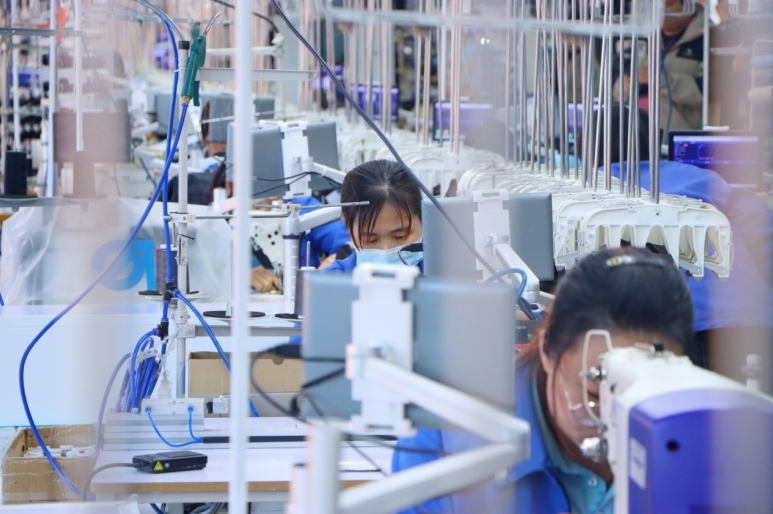
Garment manufacturing is the process of transforming design concepts into actual wearable clothing.
The garment manufacturing industry is not only the core of the fashion world, but also an important driving force for global economic development. It is related to the display of creativity and aesthetics, and also involves multiple fields such as material science, engineering technology, and market strategy.
The garment manufacturing process can be roughly divided into three stages: pre-production, production, and post-production, each stage carrying different technical requirements and challenges. With the advancement of technology, garment manufacturing technology is constantly innovating, from automated production to the application of smart materials, bringing unprecedented changes to the industry.
Pre-production stage of garment manufacturing
The pre-production stage of garment manufacturing is a series of preparations from receiving orders to the official start of production, covering the whole process from creative sparks to production preparation.
The key to this stage is to ensure that all the conditions necessary for production are in place, including the finalization of the design scheme, the procurement of raw materials, and the detailed planning of the production plan.
The length of pre-production time varies depending on various factors, mainly on the complexity of the system ordered by the consumer and whether there are ready-made components in the supplier's warehouse.
Design and development stages involve details in garment manufacturing
In the design and development stage, the main processes include conceptualization, pattern making, and other links, with specific details as follows:
- 1. Conceptualization: Designers propose preliminary design concepts based on market demand, fashion trends, and brand positioning. This process may involve multiple brainstorms and creative collisions to ensure the uniqueness and market competitiveness of the design scheme.
- 2. Pattern Making: Once the design concept is determined, the pattern maker (also known as a technical designer) starts creating the pattern templates for garment manufacturing based on the design draft. This includes converting the design draft into precise patterns that can be used for cutting and sewing, usually including both flat patterns and three-dimensional cutting methods. Flat pattern making mainly relies on computer-aided design software (CAD), while three-dimensional cutting relies more on manual skills and knowledge of human body mechanics.
Detail processing: During the pattern making process, special attention should be paid to detail processing, such as the design position and shape of darts, pleats, pockets, buttons, etc., to ensure the comfort and aesthetics of the garment manufacturing.
Sample and modification: After the preliminary pattern is completed, a sample garment is usually made for trial and adjustment. Based on the trial results, the designer and pattern maker will make multiple modifications and improvements to the pattern until a satisfactory effect is achieved.
The processes or details involved in purchasing materials for garment manufacturing
Purchasing materials is an important part of the pre-production stage, the main process includes fabric selection, decoration and accessory purchasing, etc., the specific details are as follows:
- 1. Fabric selection: Based on design requirements and cost budget, the purchasing department will conduct market research and select suitable fabric suppliers. When choosing fabrics, various factors such as texture, color, pattern, durability, price, and environmental properties need to be considered. Additionally, details such as delivery lead time and payment methods need to be negotiated with the suppliers.
- 2. Decoration and accessory procurement: In addition to fabrics, it is also necessary to procure various decorative materials and accessories, such as zippers, buttons, embroidery threads, labels, etc. The selection of these materials and accessories needs to match the overall design style of the garment and comply with relevant quality standards and regulatory requirements.
Sample confirmation: Before formal procurement, it is usually necessary to request samples from the supplier for confirmation. After the samples are confirmed to be correct, a procurement contract is signed for bulk procurement.
Inventory management: The purchased materials need to be properly managed in inventory to ensure timely supply during the production process. At the same time, quality inspection and quantity verification of fabrics are also required to avoid production delays or quality issues caused by material problems.
Processes or details involved in planning and cost calculation
Planning and cost calculation are indispensable parts of the pre-production stage, the main processes include budget preparation, timeline estimation, etc., with specific details as follows:
- 1. Budget preparation: Based on the design scheme and material procurement plan, a detailed production budget is formulated. The budget content usually includes raw material costs, labor costs, manufacturing expenses (such as equipment depreciation, utilities, etc.) and expected profits. Budget preparation requires comprehensive consideration of various factors, such as production efficiency, material loss rate, and market price fluctuations.
- 2. Timeline estimation: Estimate the timeline of the entire production process based on the production plan and order requirements. Timeline estimation needs to consider the time consumption of each production link and possible delay factors (such as untimely material supply, equipment failure, etc.), to ensure that the production schedule can be completed on time.
Detail planning: During the planning and cost calculation process, it is also necessary to pay attention to some detailed issues, such as the optimization of the production process, the rationality of personnel allocation, and the effectiveness of cost control. Proper handling of these details will help improve production efficiency and quality levels, reduce production costs and risks.
The production stage of garment manufacturing
The production phase of garment manufacturing is the key process that transforms the designs, materials, and plans prepared in the pre-production phase into actual products. This phase mainly includes processes such as fabric spreading, cutting techniques, sewing, assembly line processes, ironing, and packaging.
Here are the processes and the information or details that need to be noted:
1. Fabric spreading
Process description: Fabric spreading is to neatly place the selected fabric on the cutting table according to production requirements, so as to facilitate subsequent cutting.
Note: Ensure the fabric is smooth and wrinkle-free to avoid affecting the cutting accuracy. Adjust the spreading tension and direction reasonably according to the fabric characteristics and cutting requirements. Pay attention to the front and back of the fabric to ensure the correct cutting direction.
2. Cutting technology
Process description: Cutting technology is the precise cutting of the spread fabric according to the cutting diagram to form the required cutting pieces.
Note: Use advanced cutting equipment to ensure precision and efficiency in cutting. Select the appropriate cutting tools and parameters based on the characteristics of the fabric to avoid damaging the fabric. During the cutting process, carefully check the quality of the cut pieces to ensure there are no issues such as damage or rough edges.
3. Sewing in garment manufacturing
Process description: Sewing is the process of stitching the cut pieces together according to design requirements to form the basic structure of garment manufacturing.
Note: Choose the appropriate sewing thread and stitch spacing according to the garment style and fabric characteristics. Ensure that the sewing stitches are even, smooth, and free from skipped stitches, broken threads, and other issues. Pay attention to the sewing sequence and splicing method to ensure the stability and aesthetics of the garment structure.
4. Assembly line process
Process description: Assembly line technology is based on sewing, where various parts of the garment (such as collars, cuffs, pockets, etc.) are assembled and fixed.
Note: Ensure that the dimensions of each component are accurate and the shape is consistent to avoid deviations during assembly. Use appropriate fixing methods and tools to ensure that the components are firm and reliable. Pay attention to the assembly sequence and techniques to ensure the rationality and aesthetics of the overall garment structure.
5. Ironing
Process description: Ironing is a process of shaping and setting the sewn garments, making the garments look flat and crisp.
Note: Select the appropriate ironing temperature, humidity, and pressure according to the characteristics of the fabric. During the ironing process, carefully check the surface of the garment to avoid problems such as extreme light and scorching. Pay attention to the ironing sequence and technique to ensure that all parts of the garment are smooth and consistent.
6. Packaging
Process description: Packaging is the folding, bagging, or boxing of ironed garments for storage and transportation.
Note: Select the appropriate packaging methods and materials according to the garment style and customer requirements. Ensure that the garments are not damaged or contaminated during the packaging process. Label the packaging with clear product information, size, and precautions.
The production phase of garment manufacturing involves multiple key processes, each of which requires attention to the corresponding information or details to ensure product quality and production efficiency.
The post-production stage of garment manufacturing
The post-production stage is an important link in the garment manufacturing process. It is necessary to ensure that the garment products meet the established quality standards and enter the market smoothly. This stage mainly includes two core processes: quality assurance and distribution, each of which has its own details that need attention.
quality assurance
Process description:
Quality assurance is the process of thoroughly inspecting finished garments to ensure they meet established quality standards and customer requirements. This process runs throughout the entire production process, but it is particularly important in the post-production stage.
Pay attention to the details:
Inspection Procedure
Develop detailed inspection standards and processes, including appearance inspection (such as thread treatment, stains, damage, etc.), size measurement, functional testing (such as the use of zippers, buttons, pockets, etc.). Use professional inspection equipment and tools to ensure the accuracy and consistency of the inspection results. Implement a multi-level inspection system, such as self-inspection, mutual inspection, and special inspection, to improve the comprehensiveness and effectiveness of inspection.
2. Compliance standards
Ensure that garment products comply with relevant domestic and international laws and regulations, industry standards, and customer-specific quality requirements. Pay attention to compliance in environmental protection and safety, such as testing for banned substances, flammability testing, etc. Timely update and understand the latest changes in compliance standards to adjust production processes and inspection standards accordingly.
Distribution in garment manufacturing
Process description
Distribution refers to the process of delivering qualified garment products to customers or sales terminals through logistics channels. This process involves logistics management, selection and optimization of delivery channels, etc.
Pay attention to the details in garment manufacturing
1. Logistics Management:
Develop reasonable logistics plans and distribution schemes to ensure that products can be delivered to their destinations on time and safely. Choose reliable logistics partners, paying attention to their transportation capacity and service quality. Conduct real-time tracking and monitoring of the logistics process to respond promptly to possible delays or issues.
2. Delivery channels:
Choose the appropriate delivery channels based on customer needs and product characteristics, such as express delivery, logistics lines, and sea freight. Consider the balance between cost and efficiency, and select the most cost-effective delivery method. Ensure the stability and reliability of the delivery channels to avoid customer dissatisfaction or complaints due to channel issues.
Quality assurance and distribution processes in the post-production stage are key links to ensure the quality of garment products and market supply. Through strict quality inspection and efficient logistics management, garment manufacturing companies can enhance customer satisfaction and market competitiveness.
The method of garment manufacturing
The methods of garment manufacturing are mainly divided into in-house manufacturing and outsourced manufacturing. Each method has its own unique advantages and challenges.
Advantages and challenges of internal manufacturing
Advantages:
1. Quality Control: Internal manufacturing allows companies to directly control the entire production process, from raw material procurement to finished product delivery, ensuring that product quality meets high standards. Companies can adjust production techniques and processes according to their own needs, promptly identify and solve problems.
2. Flexibility: Internal manufacturing allows companies to quickly respond to market changes and customer demands, adjust production plans, launch new products or improve existing products. This flexibility helps companies maintain a leading position in a highly competitive market.
3. Intellectual property protection: Internal manufacturing helps to protect the core technology and design intellectual property of the enterprise, avoiding technology leakage and infringement risks.
Challenge:
High Cost: Internal manufacturing requires companies to invest a large amount of funds in equipment purchase, production line construction, personnel training, etc., resulting in higher production costs. In addition, with technological advancements and changes in market demand, companies need to constantly update equipment and processes, further increasing the cost burden.
2. Management difficulty: Internal manufacturing involves multiple production links and collaboration between departments, making management more difficult. Enterprises need to establish a comprehensive management system and processes to ensure the smooth progress of the production process.
3. Capacity constraints: Internal manufacturing is limited by the company's own production capacity, making it difficult to meet the needs of large-scale production or sudden orders. This may lead to the company missing market opportunities or failing to deliver orders on time.
Advantages and challenges of outsourcing garment manufacturing
Advantages:
1. Cost reduction: Outsourcing manufacturing allows companies to utilize external resources, reduce fixed and operational costs. Contract manufacturers usually have economies of scale and professional production equipment and technology, which can provide more competitive prices.
2. Specialized division of labor: Outsourcing manufacturing allows companies to entrust non-core businesses to professional contract manufacturers, thereby focusing on core business and product research and development. This specialized division of labor helps to improve production efficiency and product quality.
3. Flexible response to market changes: Outsourcing manufacturing enables enterprises to quickly adjust production capacity and supply chain layout, flexibly respond to market changes and customer demands. Contract manufacturers usually have stronger market sensitivity and flexibility, and can provide more comprehensive support for enterprises.
Challenge:
1. Quality control risks: Outsourcing garment manufacturing poses quality control risks. Subcontractors may fail to meet product quality standards due to factors such as technical skills, management capabilities, or profit motives. Enterprises need to establish a comprehensive quality monitoring system and cooperation mechanisms to ensure that product quality meets standards.
2. Supply chain risk: Outsourced manufacturing involves multiple supply chain links and partners, and there is a risk of supply chain interruption or delay. Enterprises need to strengthen supply chain management to ensure stable supply of raw materials, controllable production schedules, and smooth logistics and transportation.
3. Intellectual property risks: The outsourced garment manufacturing process may involve sensitive aspects such as technology transfer and design sharing, which carry the risk of intellectual property leakage. Enterprises need to sign strict confidentiality agreements and intellectual property clauses with the subcontractor to ensure that their own rights and interests are not infringed.
In-house manufacturing and outsourced manufacturing each have their own advantages and challenges. When choosing a manufacturing method, companies need to weigh and make decisions based on their actual situation and market demand. Regardless of the manufacturing method chosen, companies need to strengthen internal management, quality control, and supply chain management to ensure product quality and market competitiveness.
Supply chain management in garment manufacturing
Supply chain management connects raw material suppliers, manufacturers, distributors, and ultimately consumers.
The role of supply chain management in garment manufacturing
Supply chain management plays a crucial role in garment manufacturing, and its role is mainly reflected in the following aspects:
1. Improve production efficiency and quality control in garment manufacturing
By optimizing supply chain management, enterprises can achieve efficient collaboration of information and logistics, reduce waiting time and waste in the production process, thereby improving production efficiency and product quality.
2. Reduce costs in garment manufacturing
Supply chain management helps enterprises optimize procurement costs, production costs, inventory costs, and logistics costs, thereby reducing total costs. Through centralized procurement, mass production, lean inventory management, and other means, enterprises can effectively control costs and increase profits.
3. Enhance the speed and flexibility of market response
Supply chain management enables enterprises to quickly respond to changes in market demand, flexibly adjust production plans and inventory, quickly launch new products, improve market response speed and flexibility, and meet the diverse needs of consumers.
4. Enhance competitiveness and brand influence in garment manufacturing
By improving product quality, reducing costs, and enhancing market response speed, supply chain management can significantly enhance the competitiveness and brand influence of enterprises, helping them stand out in the fierce market competition.
5. Promote industrial transformation and upgrading in garment manufacturing
Supply chain management strengthens the cooperation and communication between enterprises and suppliers, manufacturers, wholesalers, retailers and other links, promotes the coordinated development of the entire industry chain, and promotes the transformation, upgrading and sustainable development of the garment manufacturing industry.
Common problems in supply chain management
The main problems faced by supply chain management in garment manufacturing include:
1. Complexity in garment manufacturing
The supply chain involves multiple links and participants, requiring coordinated management, which is prone to problems such as information asymmetry and inadequate risk management.
2. Instability in garment manufacturing
The market environment and consumer demand often change, leading to the need for constant adjustment of the supply chain, increasing the difficulty of management.
3. Risk
There are risks in all links of the supply chain, such as logistics delays, quality issues, supplier failures, etc. These risks may cause significant losses to the enterprise.
4. Cost
Supply chain management requires a large investment of manpower, material resources and financial resources, with high costs, and puts forward high requirements for the enterprise's resource allocation and management capabilities.
Innovative solutions for supply chain management in garment manufacturing
In response to the above issues, the innovative solutions for supply chain management mainly include:
1. Digital transformation
Using advanced technologies such as cloud computing, big data, and artificial intelligence, we achieve centralized management of supply chain data and automation of business processes, improving the transparency and accuracy of information flow, and enhancing the controllability of the entire supply chain by enterprises.
2. Business process reengineering
On the basis of digitalization, the business processes of supply chain management are reengineered and optimized, simplifying processes, reducing links, and achieving a more automated and efficient process design.
3. Supply chain cooperation
Strengthen digital collaboration with suppliers, customers and other upstream and downstream enterprises, achieve business interconnection and data sharing, and improve the collaborative efficiency of the supply chain. Build a supply chain ecosystem to jointly address market challenges.
4. Risk management mechanism
Establish a comprehensive risk management mechanism, identify and assess risks in various links of the supply chain, take appropriate measures, and reduce the probability and loss of risk occurrence.
5. Continuous optimization in garment manufacturing
Pay attention to market changes and consumer demands, seek possibilities to improve supply chain efficiency and reduce costs, and continuously optimize supply chain design. Through continuous improvement and innovation, maintain the competitiveness and adaptability of the supply chain.
Supply chain management plays an important role in garment manufacturing, and it also faces many challenges. By adopting innovative solutions, enterprises can continuously optimize supply chain management, improve production efficiency, reduce costs, and enhance market response speed, thus remaining invincible in the fierce market competition.
Technological progress and sustainable practices in garment manufacturing
The technological progress scene of garment manufacturing
In the garment manufacturing industry, technological progress is driving the transformation of the industry at an unprecedented rate. The integrated application of manufacturing automation, robots, and artificial intelligence has greatly improved production efficiency, reduced costs, and enhanced product quality.
Manufacturing automation
The automated production line has achieved full automation from fabric cutting, sewing to finished product packaging by introducing advanced robotic arms, automated sewing machines, intelligent cutting systems, and other equipment. This not only reduces manual operations but also improves production precision and speed. The application of software such as Advanced Planning and Scheduling System (APS) further optimizes production plans, achieving rational allocation and efficient utilization of production resources.
Robot applications
With the development of artificial intelligence and machine vision technology, collaborative robots are gradually occupying an important position in the garment manufacturing industry. They can work closely with human employees to complete tasks with high repetition and labor intensity, such as handling, sorting, and packaging. Robots can also achieve complex sewing and fine processing through precise control, improving the fineness and consistency of products.
Artificial intelligence integration
The application of artificial intelligence in garment manufacturing is becoming increasingly widespread. Through big data analysis and machine learning algorithms, enterprises can predict consumer demand, optimize inventory management, and formulate precise production plans. In terms of quality control, artificial intelligence can monitor various parameters in the production process in real time, timely detect and correct deviations, ensuring stable and reliable product quality.
Sustainable practices in garment manufacturing
With the increasing awareness of global environmental protection, sustainability is becoming increasingly important. The garment manufacturing industry is actively adopting sustainable practices, including the use of environmentally friendly materials, the development of waste reduction technologies, and the implementation of circular economy models to reduce the impact on the environment.
Environmentally friendly materials
More and more garment manufacturing companies are starting to use environmentally friendly materials, such as organic cotton, recycled nylon, and recycled polyester. These materials reduce the dependence on natural resources and lower carbon emissions and environmental pollution during the production process. For example, the award-winning uniforms of Chinese athletes have chosen environmentally friendly fabrics such as renewable nylon and recycled polyester, achieving a carbon reduction of more than 50% from raw materials to production.
Waste reduction technology
Waste and defective products generated during garment manufacturing are one of the significant sources of environmental pollution. To reduce waste production, companies have started adopting advanced waste reduction technologies. By optimizing cutting processes, increasing fabric utilization, and strengthening waste recycling and reuse, companies can significantly reduce the amount of waste generated. Some companies also use new destruction technologies such as high-temperature high-pressure combustion, chemical treatment, and biodegradation to harmlessly treat waste that cannot be reused, reducing the negative impact on the environment.
The garment manufacturing industry continuously promotes the green development of the industry through technological advancement and sustainable practices. The integrated application of automation, robotics, and artificial intelligence improves production efficiency and product quality; the use of eco-friendly materials and waste reduction techniques reduces environmental pollution and resource waste. These efforts help enhance the competitiveness of enterprises and promote the sustainable development of the entire industry.
Garment manufacturing is a combination of art and technology, and is an active response to social responsibility and environmental protection. With the continuous advancement of technology and the deepening of the concept of sustainable development, the garment manufacturing industry is moving towards a more efficient and environmentally friendly future.
Smart Sourcing Content Team
Article by Smart Sourcing Content Team
The Smart Sourcing Content Team is committed to delivering high-quality, easy-to-understand information that helps our audience navigate the complexities of global sourcing. Our team of writers has extensive experience in producing articles across various fields such as procurement, supply chain management, market trends, and industry best practices. We specialize in sectors like apparel, textiles, and consumer goods, providing targeted insights to help businesses in these industries optimize their sourcing strategies and stay competitive.
Grow your business with TradeAider Service
Click the button below to directly enter the TradeAider Service System. The simple steps from booking and payment to receiving reports are easy to operate.




